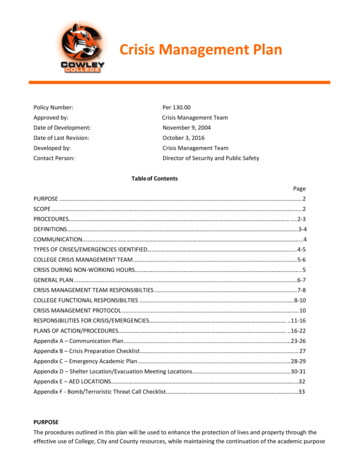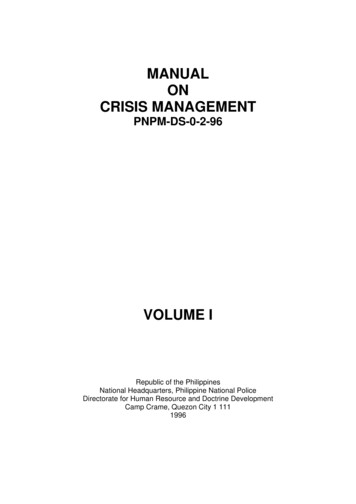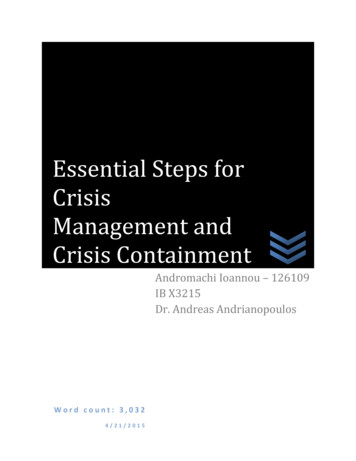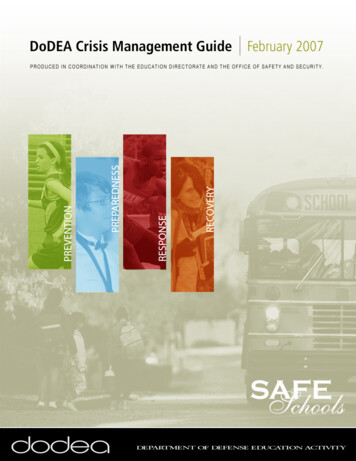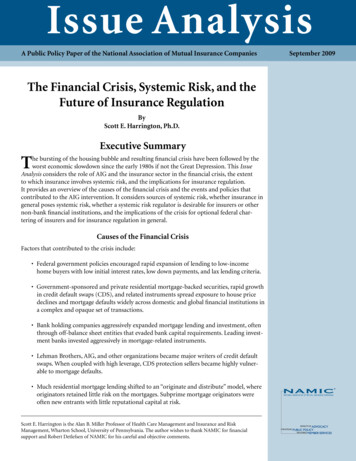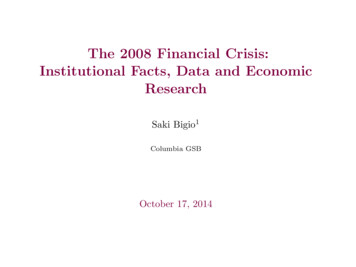
Transcription
The 2008 Financial Crisis:Institutional Facts, Data and EconomicResearchSaki Bigio1Columbia GSBOctober 17, 20141 / 115
The 2008-2009 Financial CrisisThe 2008-2009 Financial Crisis was the biggest postwar era downturn2 / 115
The 2008-2009 Financial CrisisThe 2008-2009 Financial Crisis was the biggest postwar era downturnThese are the main macroeconomic implications.3 / 115
The 2008-2009 Financial CrisisLog GDP and PathLog Output9.89.69.49.22000200520102015Figure: Log-GDP around crisis period.4 / 115
The 2008-2009 Financial CrisisDeviation from Historical Growth RatesOutputPercent5.02.50.0 630 30 10 2020082010201220142008Hours201020122014Marginal Product of Labor0.0110.0 2.5107.5PercentPercent2014 5.0 7.5105.0102.5100.0 10.020082010201220142008201020122014Figure: % Deviations from Pre-crisis level correcting for trend.5 / 115
The 2008-2009 Financial CrisisOutputConsumptionInvestmentHoursWagesMPLData 2007Q4-2009Q2-4.99%-3.86%-42.2%-9.52%6.94% Table: Financial Crisis Data. Source: Data is obtained from the FederalReserve Bank of St. Louis FRED system. Figures correspond to the percentchange between the levels in the last quarter of 2007 and the levels the secondquarter of 2009. Pre-crisis growth rates are subtracted.6 / 115
The 2008-2009 Financial CrisisThese presentation presents some facts, policy implications,institutional features and dataThroughout the presentation we discuss some personal thoughts andrelate them to the recent macro-finance literature7 / 115
Leading up to the Crisis8 / 115
The Rise in House PricesHouse prices rose steadily from the 1990s to 2006The appreciation in house prices exceeded 10% per year from early 2004 toearly 2006The home-ownership rate rose to a record level of 68.6% of households by2007It was not clear whether prices would be sustained9 / 115
House Prices, 1994-2009Case Shiller Price Index210180150120200020052010Growth of Home Prices2015US Home Ownership6968Percent12 Month % Change200BostonChicagoLos AngelesMiamiNew YorkSan FranciscoWashington, D.C. 20 12Figure: Home prices and ownership in the United States.10 / 115
The Creation of Subprime MortgagesTraditional mortgages required substantial down payments; typically 20%of the house price needed to be put down to receive a mortgage for 80% ofthe pricethe total value of the house was collateral for the mortgage and wouldexceed the loan, reducing the default riskBut as house prices rose, leading mortgage lenders began to createsubprime loans for people who wouldn’t normally qualify to buy homes11 / 115
The Creation of Subprime MortgagesLenders reduced down payments and even offered mortgages with zeromoney downSubprime lenders also loosened rules about borrowers’ incomes– oftenthere was no documentation of incomeMost subprime loans had adjustable interest rates, with a low initialinterest rate (often called ”teaser rates”) that would later rise in a processknown as mortgage reset12 / 115
The Creation of Subprime MortgagesAs long as housing prices kept rising, both lenders and borrowers thoughtthe subprime loans would work outif a borrower was short on cash, he could take out a second mortgagebecause the higher value of his home gave him more collaterala borrower could also always sell his house at a higher price to pay offthe loansIndeed subprime lending was profitable in the late 1990s and early 2000sbecause default rates were moderate13 / 115
The Rise of SecuritizationTraditionally when a bank made loans, these became part of the banksassetsOver the last decades this changedToday, banks now “securitize” many of their loans14 / 115
The Rise of SecuritizationRather than holding loans as part of their assets, banks sell many of theirloans to a large financial institution, called the securitizerThe securitizer gathers a pool of loans and transforms the pool intosecurities that traded in financial marketsfor example, a pool might be 100 million worth of mortgage loans topeople with certain credit scoresThe security entitles the owner to a share of the payments in the loan poolThese securities are bought by financial institutions, including othercommercial banks, investment banks, pension funds, insurance companiesor mutual funds15 / 115
Securitization - TranchingSecuritization is more than selling loansPools of loans face agency problems in the effort to monitor or select loansTo resolve the agency problem the industry designed “tranching”mechanismsBy tranching loan pools, the issuer of securities keeps residual riskPools of mortgages are divided into securities of different seniority a junior tranch pays-off only if the senior tranches are payed firstTranching allowed MBS issuers to raise capital from more risk averseagents (pension funds, money markets)16 / 115
Securitization - Tranching and Tail EventsTranching makes valuations of assets particularly sensible to assumptionsabout correlationsSimple thought experiment. Coin toss gamePay 1 for heads, -0.5 for tailsThink of a sequence N of trialsPlayer sells senior security offering N*0.1 in return if return is N*0.1Player is residual claimantStructure changes risk structure of the securityEx-ante valuation for the issuer depends on correlation assumption andtranchingFor i.i.d, N large, there’s low risk. Small changes in correlations canincrease risk exposureSensitivity also depends on the security design17 / 115
Securitization18 / 115
Fannie and FreddieHome mortgages were really the first market of loans to be securitizedThe two largest issuers of mortgage-backed securities (MBSs) were FannieMae and Freddie MacFannie Mae was created in 1938 as part of the New Deal, Freddie Mac wascreated in 1970Fannie and Freddie are government sponsored enterprises–privatecorporations with stocks that are traded on the NYSE but are linked tothe government and were established by the governmentThe purpose was to increase the supply of mortgage loans in a large scaleand thereby help more people achieve homeownership19 / 115
Fannie and FreddieInitially Fannie and Freddie held onto all the mortgages they bought withthe funds they raisedIn the 1970s however they started issuing mortgage-backed securitieswhich they sold to other financial institutionsthe buyers of the securities became entitled to the interest and theprincipal that borrowers made on the underlying mortgageOver half of U.S. mortgage debt is securitized by Fannie and FreddieInitially they purchased only prime mortgages–borrowers with low defaultrisk and high credit scores20 / 115
Securitization and the Investment BanksBefore the 1990s there was little securitization beyond the prime MBSscreated by Fannie and FreddieIn the early 2000s, the five largest investment banks, Goldman Sachs,Morgan Stanley, Merrill Lynch, Lehman Brothers, and Bear Stearns, alsostarted issuing mortgage-backed securities (MBS)However, securities issued by the investment banks were subprime: theywere loans to people with weak credit histories21 / 115
Securitization and the Investment BanksTo create these securities, the investment banks purchased home mortgageloans from the original lenders (originators) and bundles them togetherSub-prime borrowers would eventually pay higher interest rates thantraditional mortgage borrowersAs a result, securities backed by subprime promised high returns to theirowners as long as the borrowers made their mortgage paymentsInvestment banks sold safe tranches of mortgages holding on to riskiertranches for themselves (tranching)22 / 115
Fannie and FreddieAs mentioned before, Fannie and Freddie initially purchased only primemortgages–low default risk and high credit scoresHowever, in the early 2000s they began to purchase subprime mortgagesThe securities they sold to other institutions were still backed entirely byprime mortgagesFannie and Freddie held onto the subprime mortgages they purchased23 / 115
All together: Subprime, Securitization, and HousePricesAs investment banks saw profits in subprime, they began securitizing moresubprime mortgages and held onto a larger share of these securitiesAt the same time, they bore risk from junior tranchesSecuritization provided the means to diversify riskSecuritization furthermore provided more funds for subprime loansLess risk and more volume led banks to require less collateral for subprimeloansIn turn, more subprime lending increased the demand for housing, leadingto higher house prices24 / 115
Foreseeing the crisisFew people saw the risks since few anticipated the sharp decline in housingprices at a nationwide levelAlan Greenspan in 2005: “Overall, while local economies may experiencesignificant speculative price imbalances, a national severe price distortion(i.e. a housing bubble) seems most unlikely in the United States, given itssize and diversity”In fact, Greenspan was right from a historical perspective: there had beenvery low correlations in housing price movements in the pastLowest price growth correlation in a U.S. cities jumped from -60% to 17%and highest from 94% to 96%Based on these low correlations, risks were low, and the whole industryarchitecture made sense25 / 115
Taking stock IA popular view (press and academia) is that the system of securitizationwas plagued by greedy bankers and real estate agentsIndeed, a lot of dirt was found under the carpet. (What crisis doesn’t raisecarpets?)In my view, the heart of the problem was systematic mispricingThe system of securitization grew based on low historical correlationassumptions. The problem is, the system itself, build correlation!Securitization, and subprime lending led to a correlation that would makethe system vulnerable to small shocks26 / 115
Taking stock IIAs argued before, securitization led ABS-issuers to bare residual riskThese changes in the risk structure lead small shocks to become largelosses for themBased on historical nationwide correlations, the probability of such losseswas lowRelated to models with financial intermediaries, small shocks (Katrina forexample) would affect the ABS issuers net-worth. These would lead themto cut-back from lendingConstrained lending could move prices in many regionsReductions in home prices would trigger national defaults causing a spiraleffectWith higher correlations, no-one would want to bare risksBoz and Mendoza (2010), have a paper with a similar flavorShould we expect systematic mistakes of this magnitude in the nearfuture?27 / 115
The Housing Crash and the Financial Crisis28 / 115
The Crash in House PricesHouse prices began to fall dramatically in 2006Homeowners now had mortgage payments they couldn’t affordWith falling house prices, they couldn’t borrow more and theycouldn’t sell their houses for enough to pay-off their mortgagesAs a result, delinquency rates on subprime mortgages rose together withforeclosuresThe effects of falling housing prices also spread to prime mortgages29 / 115
Subprime MortgagesSubprime graph goes here.30 / 115
The Subprime CrisisFalling house prices led many subprime borrowers to defaultAs defaults rose, the financial markets realized that securites backed bysubprime mortgages would produce less income than previously expectedThis led many investors to simultaneously try to sell off MBSs, leading toa huge decline in their pricesThe crash in the prices of these securities caused large losses to theinvestment banks and other owners of the securities31 / 115
The Subprime CrisisInstitutions that had made subprime loans began to suffer large lossesNew Century Financial and Ameriquest declared bankruptcy in 2007Other financial institutions that held securities backed by subprimemortgages suffered billions in lossesHowever, no one thought this would lead to a major financial crisis:by mid-2007, financial institutions were estimated to lose a total of 150 billion, but this is not very much compared to total US GDP of 14 trillion32 / 115
The Liquidity Crisis and Interbank MarketsAs losses on subprime mortgages rose, banks became suspicious about thesolvency of one anotherDue to these worries, banks began to reduce credit availability to eachother, lenders became scarceOn August 9-10, 2007, these fears showed up in the federal funds market,as the federal funds rate increased far above the Fed’s targetThe Fed responded with open market operations–it purchased largeamounts of government bonds, pushing cash into the system and reducinginterest rates33 / 115
The Run on Northern RockIn September 2007, Northern Rock Bank in the U.K. ran short of liquidassetsIt asked Bank of England for an emergency loanThe Bank of England approved the loan, but the news caused depositorsto lose confidenceThis produced the UK’s first bank run in over a century: depositorsrushed to withdraw funds (since only 90% of deposits were insured)The run lasted three days until the British govt intervened and announcedit would guarantee all of Northern Rock’s deposits34 / 115
The Fed’s ResponseThe Fed responded to the freeze in interbank lending market by playingits role of lender of last resortIt encouraged banks to request loans at the discount window if theyneeded cash (rather than buying bonds)It reduced the discount rate by half a percentage pointBut very few banks borrowed discount loans, due to fear that this actionwould signal weakness35 / 115
The Term Auction FacilityIn response to the low level of discount window lending, the Fed madecredit available through special lending facilitiesIn December 2007, the Fed created the Term-Auction Facility (TAF)Under this program, the Fed lent to banks through closed-bid auctionsevery two weeks it provided a predetermined level of loans ( 25-75billion) to banks that submitted the highest interest rate bidsBanks were more eager to bid in these auctions than to take outtraditional discount loansparticipation was not publicized as widely, so these loans had less of astigma effect36 / 115
Taking Stock - Signalling WeaknessesRepo-Rollover, CPSpeculation and predatory pricingRuns by firms to demand committed loans37 / 115
The Economy begins to fall in 2007As housing prices fell, wealth fellThe reduction in wealth led to less consumption, in particular of durablegoodsConsumption and investment were also dampened by uncertainty aboutthe economyOne also sees inventories picking-up38 / 115
Monetary PolicyFed cut its interest rate target sharply, reducing its target for the federalfunds rate from 5.25 to 3.0Despite the expansionary policies pursued by the Fed, the economycontracted sharply in the second half of 2008 and early 200939 / 115
BearBear Stearns held large quantities of subprime mortgage-backed securitiesIt suffered huge losses as the prices of these securities fellIn March 2008 rumors spread that Bear might become insolventBear relied heavily on short-term borrowing to fund its asset holdingsHowever, financial institutions stopped lending to Bear or buying itsbonds once they feared that Bear would default on its obligationsAs funding disappeared, Bear ran out of money to pay off its existingloans and commercial paper40 / 115
The Fed bails out BearIn March 2008 Bear’s lawyers prepared to file for bankruptcyThe first financial rescue during the crisis occurred on March 16 2008:The Fed made a 30 billion loan to JP Morgan Chase to purchaseBearThe loan was not collateralized by JP Morgan assets but by BearStearns assetsThis led to many criticisms of the Fed (increased risk and moralhazard by saving Bear’s creditors)41 / 115
The FedIn March 2008, the Fed again reduced its target for the federal funds rateto 2.0It established the Primary Dealer Credit Facility (PDCF) which offeredloans to primary dealers in the govt securities market–the institutions thattrade with the Fed when it performs open-market operationsprimary dealers include the largest investment banks as well as commercialbanks (thus investment banks also became eligible for emergency loans)In June 2008, Ben Bernanke: “The risk that the economy has entered asubstantial downturn appears to have diminished over the last month orso”42 / 115
Fannie and FreddieBecause Fannie Mae and Freddie Mac had held onto the subprimemortgages, they suffered huge losses in 2007Mounting losses on these mortgage-backed securities threatened thesolvency of Fannie and FreddieDefault would have caused catastrophic losses to banks that held trillionsof dollars of Fannie and Freddie bondsBankruptcy would have also disrupted mortgage lending43 / 115
Fannie and FreddieOn Sept 7 2008, the government took Fannie and Freddie intoconservatorshipTreasury promised to cover Fannie and Freddie’s losses with publicfunds so they wouldn’t default on bonds they had issuedTechnically the companies remained private, but governmentregulators took control of their operationsThe government received stock that gave it 80 percent ownership in Fannieand FreddieNonetheless, it was mostly a pure giveaway since it was clear that Fannieand Freddie were insolventAs of 2010, the Fannie and Freddie rescues had cost the government morethan 200 billion44 / 115
Lehman BrothersLike Bear Stearns, Lehman Brothers had large losses on mortgage-backedsecuritiesDoubts about its survival led other institutions to cut off lending toLehmanThe Federal Reserve sought to arrange a takeover by Barclay’s, but thedeal fell through at the last minuteLehman Brothers declared bankruptcy on Sept 15 200845 / 115
Lehman BrothersLehman’s failure completely shocked financial marketsIt was the largest U.S. firm in any industry ever to file for bankruptcy, andhad been a pillar of financial system since 1850As Lehman defaulted on its borrowings from other financial institutions,these financial institutions sufferedFurthermore, since few people knew exactly how much Lehman owed andto which institutions, fears arose that many institutions would suffer lossesthat threatened their solvencyThis led to widespread financial panic46 / 115
Criticism over not bailing out LehmanCritics contend that policy makers could have done something and thatthey misjudged the harm of letting Lehman failIt’s unclear whether the Fed or Treasury could still have saved LehmanBernanke and Paulson said that they did not have the legal authority toprovide funds to LehmanThey may have also hesitated after the earlier negative reaction afterbailing Bear47 / 115
Credit Default Swaps and the AIG FiascoA Credit default swap (CDS) is a derivative tied to debt securities, such asbonds, that promise certain future paymentsA CDS buyer pays premiums to the sellerPayments on the CDS are triggered by defaults on the original securityIt is basically an insurance policy48 / 115
Credit Default Swaps and the AIG FiascoMany CDSs issued in the 2000s were tied to subprime MBSsThe sellers of CDSs on MBSs promised to pay CDS buyers if the marketprices of the underlying securities fell under a certain levelWhen prices of MBSs fell in 2006-2008, this triggered payments on CDSsFirms had used them to hedge the risk of holding MBSsFor example, in 2006 Goldman analysts started worrying that housingprices might fall, so it started buying CDSs to hedge against possible lossesOther firms used it to speculate: John Paulson’s hedge fund bet againstMBSs by purchasing CDSs on securities they didn’t own, and earned 15billion49 / 115
Credit Default Swaps and the AIG FiascoWho was selling CDSs? AIGAmerican International Group (AIG) was a giant insurance conglomerateit had issued large amounts of credit default swaps (CDS) onmortgage-backed securitiesAIGs swaps promised payments of hundreds of billions if prices of MBSsfell far enoughThey didn’t anticipate the fall in housing prices and its effects on MBSprices.In 2006, an AIG report to government regulators said the likelihood oflosses on CDSs was ”remote, even in severe recessionary market scenarios”50 / 115
Credit Default Swaps and the AIG FiascoThey turned out to be very wrongAs MBS prices fell, AIG had to make larger and larger payments toholders of its CDSs, and hence suffered large lossesIf AIG went bankrupt, it would have defaulted on all of the promisedpayments on the credit default swaps it had sold on mortgage-backedsecuritiesInstitutions would not have been compensated for losses on these securitiesAlso, individuals and businesses that had purchased insurance policiesfrom AIG would have lost their insuranceFurthermore, AIG would have defaulted on the 20 billion of commercialpaper it had issued51 / 115
The AIG BailoutThe Fed made an emergency loan of 85 billion to AIG on September 162008The Treasury also helped by purchasing AIG stockBernanke said that a failure of AIG “could have resulted in a 1930s-styleglobal financial and economic meltdown, with catastrophic implications forproduction, income, and jobs”AIG survived, but the Fed and Treasury were widely criticized for theiruse of taxpayers money52 / 115
The Money Market CrisisA final part of the September 2008 crisis involved Money Market MutualFunds (MMMFs)Money Market Mutual Funds hold Treasury bills (short-term govt bonds)and commercial paper (short-term corporate bonds), and sell shares tosaversThey yield low returns but are considered safe because assets have shortmaturities and low defaultSince they were invented in the 1970s, almost no one who put a dollar inan MMMF ended up with less than a dollarPeople came to view MMMFs as similar to bank accounts–very safe53 / 115
The Money Market CrisisOn the same day as the AIG rescue, one large MMMF, the ReservePrimary Fund, “broke the buck”: the value of a share in the fund, whichoriginally cost 1, fell to 97 centsWhy? The fund owned large quantities of Lehman Brothers commercialpaperUnlike bank deposits, government insurance does not cover shares inMMMFsThe result: there was a run on money market mutual funds on September17 and 18panicked holders withdrew 210 billion from the funds, reducing thefunds assets by 22%.On Sept 19 the Treasury Dept announced it would temporarily offerinsurance to MMMFs, but confidence remained shaky and funds assetsslipped further over the next few months54 / 115
Panic and flight to safetyQuick succession of crises at major institutions created widespreadfinancial panicThese was a new type of financial panic. It was internal to financialinstitutions. In the past, depositors would hoard to banks under fear oflosing savings. This was distrust within the system.Others suggest firms drew from credit lines fearing they wouldn’t bepromised or renewed in the future. This caused further reduction in bankliquidityFinancial institutions became fearful of any assets that appeared risky(stocks, bonds of corporations without top credit ratings, and securitiesbacked by bank loans)Formerly used credit ratings were mistrusted as they were mostly basedmodels that didn’t conceive a systemic crisis55 / 115
Flight to safetyThey dumped these assets and bought the safest assets: 3 and 6 monthTreasury bills (it was unlikely the U.S. govt would default on its debt overthe next six months)Stock Prices plummetedSecuritization fell dramatically as demand for securitized loansdisappearedThe prices of BAA-rated corporate bonds fell (bonds with moderatedefault risk), which implied a sharp rise in their interest ratesThe flight to Treasury bills pushed their prices up and interest rates fellalmost to zero56 / 115
Dow Jones Index of Stock PricesDow Jones Industrial Standard & Poor's 5002000Index150010002000200557 / 115
Securitization of Bank Loans58 / 115
Corporate Bond RatesCorporate Bond SpreadsCorporate Bond Spreads (Merrill Lynch 015High Yield Spreads (Merrill Lynch BofA)Percent4030BB20BC1002000200520102015High Yield Spreads 9 / 115
Treasury Bill RatesTreasury Bill Rates6Fed Funds Rate3 Month T Bill Rate10 Year Treasury RatePercent4202002200420062008201020122014Figure: Key Rates60 / 115
What about the other Investment Banks?On the same day as Lehman’s bankruptcy, Bank of America purchasedMerrill LynchGoldman Sachs and Morgan Stanley had held fewer mortgage-backedsecurities than the other investment banks.They lost less and were able to remain independent but needed toreassure other financial institutions that they would surviveBoth firms became bank holding companies on September 21, 2008This reorganization gave them the right to open commercial banksand to receive emergency loans from the Fed, but in return theyaccepted greater Fed regulation61 / 115
The Economy in 2008-2009Falling stock and house prices reduced consumers’ wealth, reducing theircredit and willingness to spendFinancial panic also caused a credit crunchBanks could not resell loans to securitizers, and hence had fewer funds tolendBanks also worried about insolvency from further losses62 / 115
The Economy in 2008-2009The run on the MMMFs was perhaps one of the most damaging events tothe economyMMMFs had to make large payments to shareholders, and this depletedthe cash they would normally have used to purchase new commercialpaper from firmsFirms across the country suddenly had difficulty selling commercial paper63 / 115
The Economy in 2008-2009Commercial paper helps cover corporations’ short-term needs for cash (tocover production costs, wages, materials, intermediate goods, etc.)The breakdown of commercial paper in Sept 2008 caused firms to slashcostsThis led to sharp reductions in output and layoffs of workers64 / 115
Commercial PaperOutstanding ABCPOutstanding Non Financial Non AB CP1250Asset Backed250FinancialUS BillionUS preads of Financial CP20121 month2 month2 month3 monthPercentPercent1.52014Spreads of Non Financial Non ABS CP1.01 month2.020101.03 month0.50.00.5 0.50.02008201020122014200820102012201465 / 115
Corporate Bond by Risk TypeBoAML AAABoAML AABoAML ABoAML BBBBoAML BBBoAML BBoAML CMoody’s AAAMoody’s BAACommercial Paper by MaturityFinancial 1MFinancial 2MFinancial 3MNon-Financial 1MNon-Financial 2MNon-Financial 37%2006Q40.4%0.39%0.39%0.38%0.35%0.34%Crisis s Peak1.56%1.66%1.78%1.25%1.24%1.23%66 / 115
The Economy in 2008-2009Commercial paper also shows that the decline in ABS-CP issuancesprecedes the Financial CP and Non-Financial CP)These is some indirect evidence of the mechanism that was at playABS Bank Losses Intermediation67 / 115
The Economy in 2008-2009As unemployment rose, this further pushed down aggregate demand:consumption fell among laid-off workersFurthermore, the unemployed could not pay their mortgages, pushinghouse prices and MBS prices down even furtherAs stock and housing prices continued to fall it caused even moreborrowers to default on bank loans, increasing the banks’ risk of insolvency68 / 115
In search for the Key mechanismUnfortunately, in economic theory we haven’t found yet a conclusion onthe strengths of different possible mechanisms that explain how thefinancial crisis spreadTaking the reduction of home prices as the starting point.It is clear that the crisis would have affected construction sectors and thebalance sheet of banks, investment banks and mutual funds.But how did it spread to the rest of the economy (manufacturing)The profession is in search of multipliers that explain the magnitude of thecrisis69 / 115
Mechanism: Investment Demand MechanismsUncertainty: although rarely modeled explicit, firms are linked in complexproduction networksContractions in construction spread directly to furniture, paint, steel,cement wood producers. These sectors, in turn, affect machine andequipment production, transport, mining sectorsAs workers get laid-off and household wealth collapses (homes and stocks),demand for durables goods collapsed immediatelyThe complexity of these relations, leads firms to face greater uncertaintyabout their demand prospects70 / 115
Taking Stock - Investment Demand MechanismsThere is a growing literature on the effects of uncertainty shocks inpresence of adjustment costsGARCH productivitySee Bloom (2007), Kahn and Thomas (2009), Arellano, Kehoe andBai (2009), Schall (2010)This literature has some identification problems. In the data, it haslag problem. Output falls before increases in firm sales dispersionDo firms face more sudden heterogeneity in TFP (which explainsdispersion in sales), or are they different ex-ante more sensible tofinancial or consumer demand conditions?The right measure of uncertainty should control for firm observables,such as leverage, location and industry type71 / 115
Taking Stock - Supply of Credit Credit RationingWorsening of Asymmetric Information: complexity could aggravateasymmetric informationThe idea is that upon a great shock hitting several sectors, firms hadbetter information on how the crisis would affect them, which productionlines, which account receivables and other assets would be more affectedAsymmetric information could lead to credit rationingKurlat(2010) and Bigio (2010) incorporate asymmetric information inproduction economies72 / 115
Taking Stock - Disruptions on InvestmentThere is a problem faced by models that disrupt investment (withrepresentative firms)Investment is a small fraction of the capital stockLucas: “How is it that production is disrupted if we have the samenumber of machines and workers?”Many models with financial frictions focus on constraints on investmentfollowing a tradition in Corp. Fianance.Macro models must incorporate additional multiplier-mechanism, typicallya “New-Keynsian” layerBut the same multiplier-mechanism makes the economy
In my view, the heart of the problem was systematic mispricing The system of securitization grew based on low historical correlation assumptions. The problem is, the system itself, build correlation! Securitization, and subprime lending led to a correlation that

